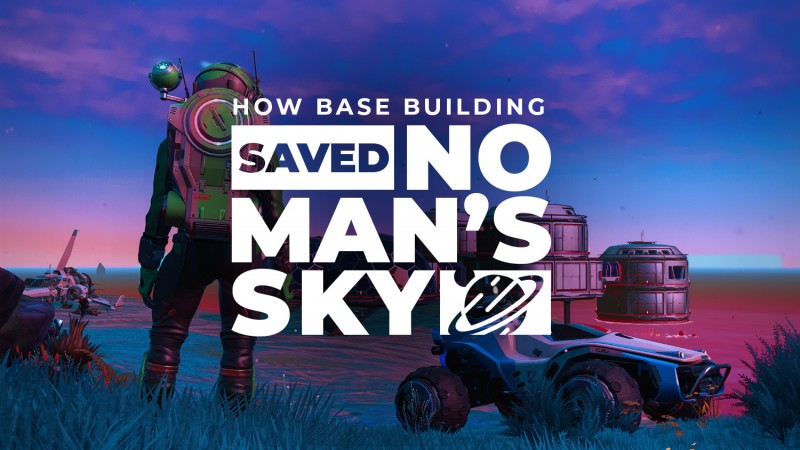
Click here to watch embedded media
Platform:
PlayStation 5, PlayStation 4, Xbox One, Switch, PC
Publisher:
Hello Games
Developer:
Hello Games
Release:
August 9, 2016
(PlayStation 4,
PC), July 24, 2018
(Xbox One), November 10, 2020
(Xbox Series X/S), November 12, 2020
(PlayStation 5), 2022 (Switch)
Rating:
Teen
We all know the story of No Man’s Sky and its unlikely resurgence. A title that, through the perseverance of Hello Games, came back from the ashes after numerous marketing blunders threatened to abbreviate its lifespan. But have we ever looked back to see exactly how Hello Games changed the course of No Man’s Sky? Sure, the game’s 14 major content updates are largely to thank for its comeback, but when did the atmospheric space title turn it all around? Is there a specific update that we can point to and say, “Yeah, that’s the moment everything changed?”
Fans and critics alike credit the game’s multiplayer update, No Man’s Sky Next, as its saving grace, however, I’d argue that the game’s early problems didn’t stem from the lack of an online player count, but instead were the product of an incomplete exploration loop. Why should I explore? What’s driving me to continue cataloging the depths of space outside of my own curiosity? Hello Games had to find the answer to these questions before they could ever hope to bring their game back from the dead.
And luckily, they did.
Despite the immense changes that No Man’s Sky has undergone since its release, the mission the game presents to its pilots is still the same today as it was back in 2016: embark on a journey across the stars, chart new planets, and uncover the mysteries of an alien universe. Only this time, they had a place to call home.
Hey, I’m Alex Van Aken from Game Informer, and this is how base-building saved No Man’s Sky. If you enjoy this video essay, be sure to watch Associate Editor Jay Guisao’s essay on The Weight of Departures and Reunions in Final Fantasy 7 Remake. Curious what score Game Informer awarded the original version of No Man’s Sky? Read the game review here.
We definitely recommend watching the video in the player above to appreciate the full experience, however here is the transcript if you need it:
Nearly five years after its original launch, No Man’s Sky is a markedly different game than the one we first played. Hello Games has not only fulfilled its original promises through myriad updates and content drops, but the studio has molded its once-lackluster survival sim into a one-of-a-kind space-faring odyssey. While the vanilla experience lacked the necessary hooks to keep players engaged for the long term, today No Man’s Sky offers a plethora of meaningful activities to participate in, including character customization, underwater settlements, cooking and farming, derelict freighters to creep through, technology trees, and most recently, tameable companions and pet trading. Hell, the game even supports virtual reality now.
In addition to introducing new and expanded systems that have bolstered the weaker aspects of No Man’s Sky, Sean Murray and team have reinforced the strengths of the original project that were worth sticking around for. Multiple facelifts have made the title’s mesmerizing planets even more arresting with the addition of fluorescent foliage and landscapes that are straight out of your favorite sci-fi films.
But the game wasn’t always this great.
Regardless of being home to over 18 quintillion planets, No Man’s Sky was largely a hollow experience at release. The title’s procedurally-generated biomes offered little variation in their offerings to the player, and without flagship features like multiplayer or large-scale space battles, it was the husk of what was first promised. However, the gameplay loop of the original release was largely the same as it is today – repair a crashed ship, explore space, and harvest resources to survive and fund further expeditions. So, what exactly was lacking?
Well, the only meaningful system that encouraged planetary investigation at launch was tied to the Analysis Visor, which is an essential multi-tool technology that allows the player to scan undiscovered flora, fauna, minerals, and points of interest. Not only does it inform you of your distance to those aforementioned curiosities, but it also allows you to upload the results of your discoveries in exchange for credits that can be spent on ships and items. Though the Analysis Visor is a well-designed game mechanic, Hello Games desperately needed to create additional avenues that would incentivize players to continue playing No Man’s Sky.
After all, the game’s main mission, which was to reach the center of the galaxy, was yet another victim to an overhyped and misleading marketing campaign. After sinking potentially hundreds of hours into the game, players that finally managed to warp to the center of the galaxy would find themselves at the start of another, stripped of everything except for what was in their inventory. The hours-long journey loses significance when the final destination strips you of your progress and rewards.
So how exactly did base building save No Man’s Sky?
Well, in a world where every atom is procedural, players needed an anchor that kept them interested and, more importantly, rewarded them for investing time into the game.
Enter the Foundation update.
Released in the Fall of 2016, the Foundation Update established the game’s base-building system. None of us knew it at the time, but this first update would ensure a legacy for No Man’s Sky, as I’d argue that it was crucial to the game’s resurgence and eventual success.
So, what sort of content did this new patch introduce? Well, for starters, players could craft modular structures and decorations. By snapping together floors, walls, and doorways, you could theoretically build the base of your dreams. Yes, No Man’s Sky was now “Minecraft in space,” and it was cool as hell. Not only did shelters serve as a home base on your chosen planet, but they also offered new functionality that made both exploration and survival less tedious. For instance, instead of fleeing to the confines of their ship’s cockpit, players could seek solace from hazardous storms by simply hanging out in their base.
For more financially-driven players, the game’s brand new farming system allowed them to cultivate and harvest crops either outside or via hydroponic labs. There’s a lot of money to be made by selling these Harvested Agricultural Substances, as the game so eloquently describes them.
But what if a player wanted to leave their home star system altogether? Wouldn’t creating a base on a planet discourage them from pursuing the far reaches of space? Luckily, no. Hello Games foresaw this potential problem and created a solution. The studio soon introduced teleporters and freighters to the game. Freighters are massive ships that can travel to new star systems alongside the player and serve as a base on wheels, while teleporters allow players to warp between a base, freighter, and any space station on a whim.
Base building also solved many quality of life issues that plagued the earliest versions of the game, specifically an overall lack of inventory space or permanent storage. With a terrestrial roof over their head, players could now store precious materials in bulk rather than discarding or selling them to create more space in their pockets.
With all of these new features to explore, No Man’s Sky was finally starting to feel like a game that prioritized player freedom rather than a ruleset that simulated worthwhile progression. Yet Hello Games didn’t stop there.
13 subsequent content updates eventually made their way to No Man’s Sky, and nearly every one of them was built on the Foundation Update’s framework. The Path Finder and Atlas Rises updates, which launched at separate ends of 2017, introduced starship and multi-tool specializations, a bevy of land-based vehicles and hangars to store them in, more base parts and exterior finishes, and a tiered crafting system that unlocked valuable items via different combinations of resources. In 2018, Hello Games released No Man’s Sky Next, Visions, and The Abyss. These three chapters established the game’s full multiplayer suite, cooperative base building, massive underwater environments and settlements, and a submarine exocraft to offer new avenues of exploration.
One of the most significant and necessary additions to No Man’s Sky was the Construction Research Station, which permanently linked the game’s base building and exploration systems after it was introduced in the Beyond update.
Here’s how it works.
Players that venture out into space can search for Salvaged Data, a valuable currency buried in underground technology modules. In order to pinpoint the item’s location, which can be scattered across almost any planet, players need to scan the environment around them with the Analysis Visor. Once excavated, the Salvaged Data can be redeemed back at their base’s Construction Research Station for a myriad of base-building parts, including agricultural modules, aquatic construction, illumination, transportation, and sci-fi decor. With the addition of the Construction Research Station, base-building serves as a natural incentive for exploration. Previously these recipes were only available from special NPC’s, but now can be more easily researched with this process. If you’d rather, the Salvaged Data that you collected can be refined into a separate currency called Nanite Clusters and instead be used to upgrade your starships and multi-tools.
Even more base tools have been added to No Man’s Sky, including Exo Mechs, a new terrain editing system, and a Nutrient Processor that works as a cooking appliance. All of these aforementioned features provided the carrot-on-a-stick that No Man’s Sky so desperately needed at launch. And still, even five years later, Hello Games continues to push update after update, molding their game into what we’ve always hoped it would be. And none of it would have been possible without the foundational gameplay systems that were introduced with base building.
Like I said, the game that is playable today is a far cry from the version that was first released. Today, No Man’s Sky is an experience that truly captures the awe of space and the wonder of the unknown. It’s a game that sparks our curiosity as we ignite our hyperdrives and warp to lightspeed in search of what’s next.
Despite everything, No Man’s Sky is simply intoxicating.




